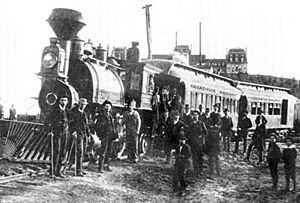Los Angeles Terminal Railway facts for kids
The Los Angeles Terminal Railway was a small train line built in the late 1880s. It was also known as the Pasadena Railway or Altadena Railway. This railway connected the towns of Altadena and Pasadena, California. It started during a time when land sales were booming, but it struggled when the land market crashed. The railway officially opened on January 31, 1888.
Contents
How the Railway Started
The idea for this railway began in 1887. It was first called the Pasadena Railway Company. Key investors included John Woodbury, James Swartout, and two wealthy men from Altadena: Andrew McNally and Colonel George Gill Green. McNally and Green were good friends.
James Swartout owned a large property in Altadena. He already had a horse-drawn train line called the Highland Railroad Company. John and Frederick Woodbury were the people who developed the Altadena community.
Andrew McNally was famous for co-founding the map-making company Rand McNally in Chicago. He moved to Altadena in 1887. George Gill Green made his money from selling special medicines. McNally invited Green to move to Altadena that same year. Both McNally and Green invested a lot in the new railway. They even had their own private train tracks built next to their homes! This allowed their private train cars to pull right up to their properties.
Where the Trains Traveled
The railway started near the Raymond Hotel in Pasadena. This hotel was a popular winter spot for many rich people from the eastern United States. The train tracks ran mostly next to Fair Oaks Avenue. Then they crossed Lincoln Avenue and headed towards the Arroyo Seco.
The line then turned north to an area called Las Casitas, which means "the little houses." It then curved east to follow what is now Harriet Street in Altadena. The tracks ran between Mendocino and Calaveras streets. The line ended on Lake Avenue, where the Altadena Post Office stands today. This path shows that the railway was planned for more than just two wealthy men.
People sometimes called the line the Pasadena Railroad or the Altadena Railroad. When it connected with Professor Lowe's Mount Lowe Railway, the Altadena end was named "Mountain Junction."
Growing the Train Line
By 1890, the Pasadena/Altadena Railway joined with other struggling train lines. These new connections reached all the way to Los Angeles. This made the railway much more successful. In July 1891, it connected again with a line that went to San Pedro. The railway was then renamed the Los Angeles Terminal Railway. Its San Pedro end, at Rattlesnake Island, was also renamed Terminal Island.
The original plan was to extend the line from Altadena all the way to Salt Lake City, Utah. However, the railway had money problems, so this big expansion couldn't happen. In 1891, the leaders of the Los Angeles Terminal Railway, including Los Angeles mayor William H. Workman, still hoped to build to Salt Lake City.
Many railroads had drawn plans for such a line, but only the Union Pacific Railroad (UP) had started building anything. Then, a very rich mining boss and banker named William A. Clark decided to act. In August, newspapers announced that Clark had bought the Los Angeles Terminal Railway. He also owned the rights to the Utah and California Railroad, a planned line from Salt Lake City to the Nevada border.
In 1901, Clark's new line was officially started in Salt Lake City. It was called the San Pedro, Los Angeles and Salt Lake Railroad. This line offered modern comforts for passengers. But Clark was most interested in carrying goods. The Union Pacific Railroad, led by E. H. Harriman, noticed this new competition. Clark's "Salt Lake Route" used some tracks that Union Pacific had built. Union Pacific even owned a part of the new line. In 1916, the Salt Lake line was renamed the Los Angeles and Salt Lake Railroad. Eventually, it became a part of the Union Pacific system, and it still is today.
Quarrying in the Arroyo Seco
By 1901, a short side track was built into the Arroyo Seco near Devil's Gate. This track was used to carry rocks from a quarry. These rocks were needed to build the breakwater at the Los Angeles Harbor. By 1903, the train service across Altadena was stopped, and the tracks were removed. It took many years for the land next to the old railway to be used again. Even today, you can still find small hints of where the train line used to be.
When the Railway Closed
By 1916, the rock quarrying in the Arroyo Seco stopped. The rocks found there were not strong enough for the harbor breakwater. By 1921, the tracks in the Arroyo and Windsor areas were taken up. Soon after, since there was no good use for the railway, the rest of the original line was completely closed down.
Today, you can still see a fenced-off path where the railway used to run. It passes between buildings and houses in Altadena, between Windsor and El Sol Avenues. Another fenced section can be seen next to the northbound Lincoln Avenue exit ramp of Interstate 210. This is where the train used to head towards the Las Casitas flats.
Images for kids




